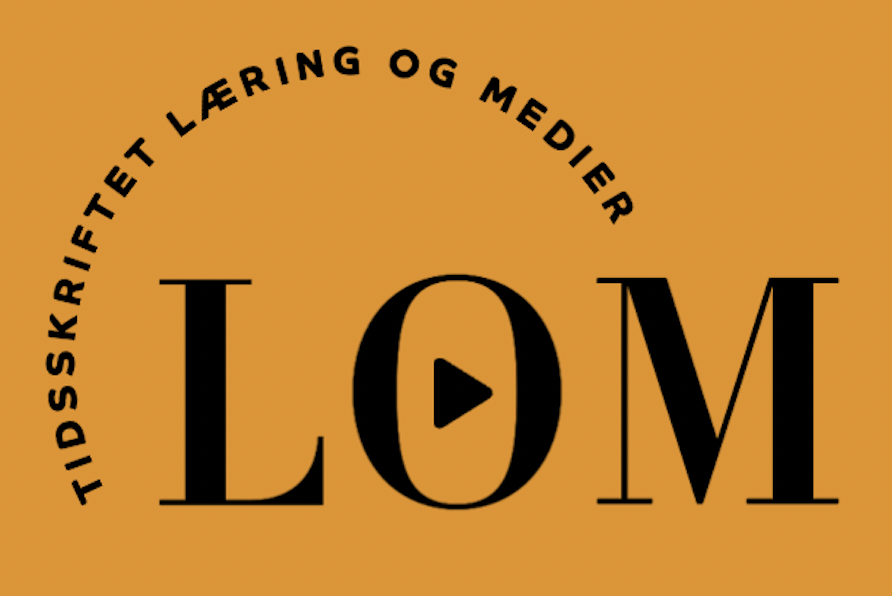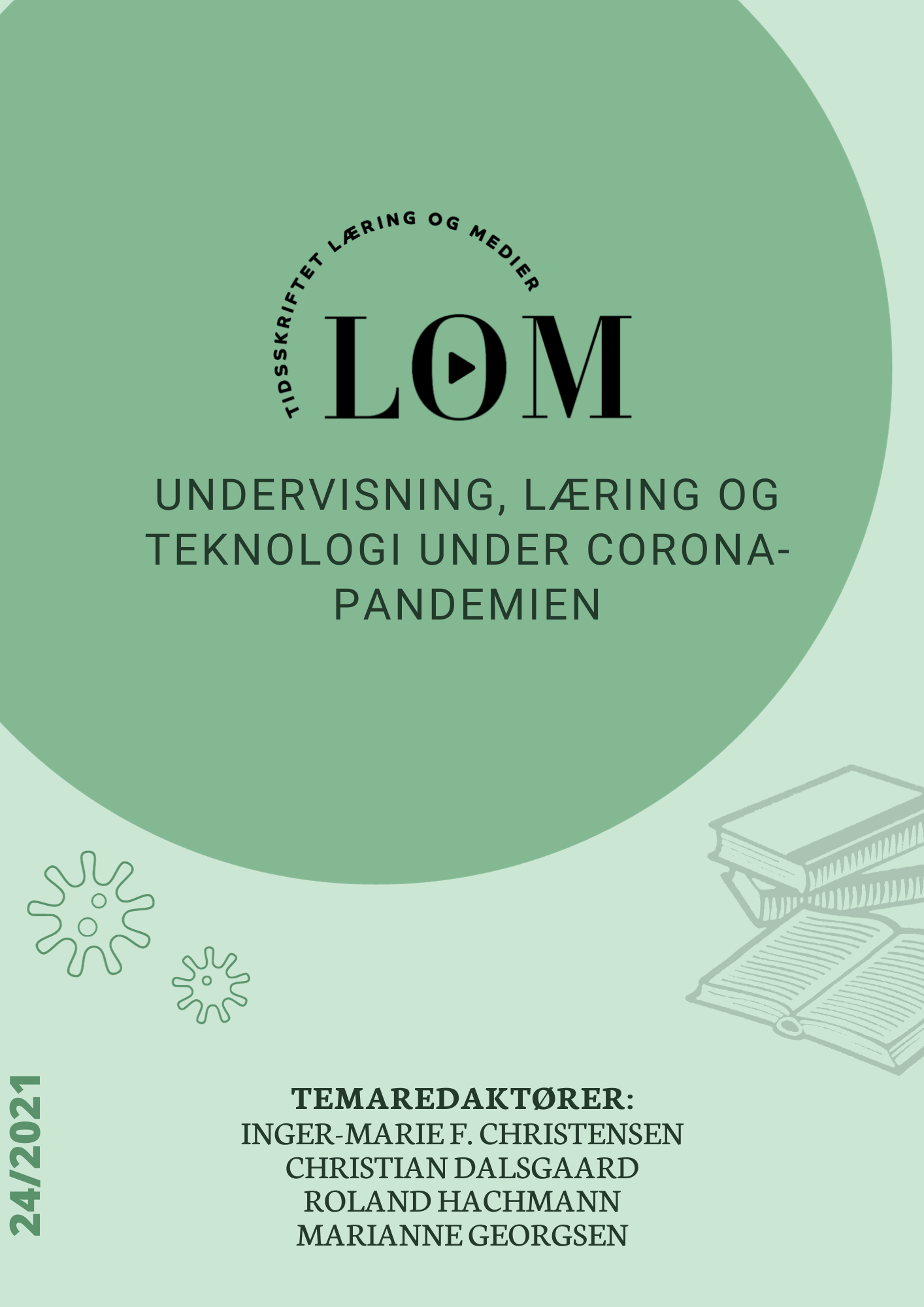Virtual teaching in Danish upper secondary schools
DOI:
https://doi.org/10.7146/lom.v14i24.128182Keywords:
Gymnasiet, Corona, Virtuel undervisning, Faglig mestring, MotivationAbstract
Upper secondary education during school closures was first and foremost emergency education related to a societal crisis. But in addition to being emergency education, it was an experiment in virtual teaching. With this in mind, this article examines students' experience of virtual teaching, with a particular focus on their experience of academic mastery and motivation. Empirically, the article is based on a mixed method design with quantitative data from questionnaire data from students (N = 2899) collected in April 2020 and focus group interviews with students (N = 44) collected in April-June 2020. The article shows that especially the academic motivation was low. On the basis of the article's analyses, a number of themes are identified that can be reflected on in relation to future virtual teaching in upper secondary schools.
Downloads
References
Aagaard, J. (2015a). Drawn to Distraction: A Qualitative Study of Off-Task Use of Educational Technology. Computers & Education, 87: 90-97.
Aagaard, J. (2015b). Media Multitasking, Attention, and Distraction: A Critical Discussion. Phenomenology and the Cognitive Sciences, 14(4): 885-896.
Al Fadda, H. (2019). The Relationship between Self-Regulations and Online Learning in an ESL Blended Learning Context. English Language Teaching, 12(6), 87-93. doi:10.5539/elt.v12n6p87
Ary, D.; Jacobs, L.C.; Razavieh, A.; Sorensen, C. (2009). Introduction to Research in education. Belmont, CA: Wadsworth Cengage Learning
Baldwin, S. A. (2019). Psychological Statistics and Psychometrics Using Stata. Texas: Stata Press.
Bandura, A. (1977). Self-efficacy: Toward a unifying theory of behavioral change. Psychological Review, 84(2), 191-215
Bandura, A. & Wood, R. (1989). Effect of perceived controllability and performance standards on self-regulation of complex decision-making. Journal of Personality and Social Psychology, 56: 805-814
Berger-Tikochinski, T.; Zion, M, & Spektor-Levy, O. (2016). Up and Down: Trends in Students' Perceptions about
Learning in a 1:1 Laptop Model - A Longitudinal Study. Interdisciplinary Journal of e-Skills and Lifelong Learning 12: 169-191
Berlingske (2021). Forskere og fagfolk i opråb: Vi står lige nu med en fagligt dummere årgang af gymnasie- og
skoleelever. Lokaliseret 21/11-21 på: https://www.berlingske.dk/samfund/forskere-og-fagfolk-i-opraab-vi-staar-lige-nu-med-en-fagligt-dummere
Bray, A., Banks, J., Devitt, A., & Eilís Ní, C. (2021). Connection before content: using multiple perspectives to examine student engagement during Covid-19 school closures in Ireland. Irish Educational Studies, 40(2), 431-441. doi:http://dx.doi.org/10.1080/03323315.2021.1917444
Brooks, S. K., Webster, R. K., Smith, L. E., Woodland, L., Wessely, S., Greenberg, N. & Rubin, G. J. (2020). The
psychological impact of quarantine and how to reduce it: rapid review of the evidence. The Lancet, 395(10227), 912-920. doi:10.1016/ S2215- 0366(20)30077-8.
Chung, L.-Y. (2015). Exploring the Effectiveness of Self-Regulated Learning in Massive Open Online Courses on Non-Native English Speakers. International Journal of Distance Education Technologies, 13(3), 61-73. doi:10.4018/IJDET.2015070105
Cook, R. D. (1977). Detection of influential observation in linear regression. Technometrics, 19(1), 15-18.
Denzin, N.K. & Lincoln, Y.S. (2000). Handbook of Qualitative Research. London: Sage Publications
Esping-Andersen, G. (1989) The three political economies of the welfare state. The Canadian Review of Sociology and Anthropology, 26: 10–36
Giannoulas, A., Stampoltzis, A., Kounenou, K., & Kalamatianos, A. (2021). How Greek Students Experienced Online Education during COVID-19 Pandemic in Order to Adjust to a Post-Lockdown Period. Electronic Journal of e-Learning, 19(4), 222-232.
Gill, B.; Goyal, R.; Hartog, J.; Hotchkiss, J.; DeLisle, D. (2020). Considerations for Reopening Pennsylvania Schools. Regional Educational Laboratory Mid-Atlantic. Retrieved April 7, 2021 from https://www.muncysd.org/cms/lib/PA06000076/Centricity/Domain/1/ReopeningPASchools.pdf
Gulten, D. C.; Yaman, Y.; Deringol, Y. & Ozsari, I. (2011). Investigating the Relationship between Curiosity Level and Computer Self Efficacy Beliefs of Elementary Teachers Candidates. Turkish Online Journal of Educational Technology –TOJET, 10(4), 248-254
Gustavsson, B. (2002). What do we mean by lifelong learning and knowledge? International Journal of Lifelong Education, 21: 13–23
Halkier, B. (2008). Fokusgrupper. Frederiksberg: Samfundslitteratur
Jelinska, M., & Paradowski, M. B. (2021). Teachers' Engagement in and Coping with Emergency Remote Instruction during COVID-19-Induced School Closures: A Multinational Contextual Perspective. Online Learning, 25(1), 303-328.
Johnson, D. & Johnson, R. (1989): Cooperation and Competition: Theory and Research. Edina, MN: Interaction
Ladd, G.W. (2003): Probing the adaptive significance of children’s behavior and relationships in the school context: A child by environment perspective. In Kail, R. (red.): Advances in child behavior and development (vol. 31): 43-104. New York, NY: Wiley.
Ladd, G.W. (2005): Children’s peer relations and social competence: A century of progress. New Haven, CT: Yale University Prenss
Larbi-Apau, J., Oti-Boadi, M. & Tetteh, A. (2018). Computer Attitude and eLearning Self-Efficacy of Undergraduate Students: Validating Potential Acceptance and Use of Online Learning Systems in Ghana. International Journal on E-Learning, 17(2), 199-226.
Madonna, S., Jr. & Philpot, V. D. (2013). Motivation and Learning Strategies, and Academic and Student Satisfaction in Predicting Self-Efficacy in College Seniors. Quarterly Review of Distance Education, 14(3), 163-168
Mehmetoglu, M., & Jakobsen, T. G. (2017). Applied statistics using Stata: a guide for the social sciences. London: Sage Publications.
Mutch, D. M. (2020). The Covid-19 Global Pandemic: A Natural Experiment in the Making. Lifestyle Genomics, 13(5), 135-137.
Peck, L.; Stefaniak, J. E. & Shah, S. J. (2018). The Correlation of Self-Regulation and Motivation with Retention and Attrition in Distance Education. Quarterly Review of Distance Education, 19(3), 1-15
Qvortrup, A. (2020a, red.). Gymnasiet i den historiske Corona-tid – et elevperspektiv. Hentet 30/11/21 fra: https://www.sdu.dk/-/media/files/om_sdu/institutter/ikv/centre/cfs/rapport.pdf
Qvortrup, A. (2020b, red.). Gymnasiet i udvikling. København: Hans Reitzels Forlag
Qvortrup, A. (2021). Long-term consequences of COVID-19 on students’ well-being and values. In Education in the North (in press)
Raykov, T. (1997). Estimation of composite reliability for congeneric measures. Applied Psychological Measurement, 21(2), 173-184.
Zhang, Y. & Wildemuth, B.M. (2009). Qualitative analysis of content. In Windemuth, B.M. (ed.). Applications of social research methods to questions in information and library science. Westport, CN: Libraries Unlimited
Tladi, L. S. (2017). Perceived Ability and Success: Which Self-Efficacy Measures Matter? A Distance Learning Perspective. Open Learning, 32(3), 243-261
The Annie E. Casey Foundation (2020). KIDS COUNT Data Book, 2020: State Trends in Child Well-Being. Retrieved March 26, 2021 from https://www.aecf.org/resources/2020-kids-count-data-book/
Tosuncuoglu, I. (2019). The Interconnection of Motivation and Self Regulated Learning among University Level EFL Students. English Language Teaching, 12(4), 105-114
TV Midtvest (2021). Venstre-kvinde om corona-undervisning: - Vi taber nogle unge mennesker på gulvet. Lokaliseret 21/11-21 på: https://www.tvmidtvest.dk/coronavirus/venstre-kvinde-om-corona-undervisning-vi-taber-nogle-unge-mennesker-paa-gulvet
Wang, Y.; Peng, H.; Huang, R.; Hou, Y. & Wang, J. (2008). Characteristics of Distance Learners: Research on Relationships of Learning Motivation, Learning Strategy, Self-Efficacy, Attribution and Learning Result. Open Learning, 23(1), 17-28
Yang, Y.-C. & Park, E. (2012). Applying Strategies of Self-Regulation and Self-Efficacy to the Design and Evaluation of Online Learning Programs. Journal of Educational Technology Systems, 40(3), 323-335
Downloads
Published
How to Cite
Issue
Section
License
Copyright (c) 2021 Ane Qvortrup, Rune Lomholt

This work is licensed under a Creative Commons Attribution-NonCommercial-NoDerivatives 4.0 International License.

Articles published in the Journal of Learning and Media are licensed under a Creative Commons Attribution-NonCommercial-NoDerivatives 3.0 Unported Licens.
Authors retain copyright and grant the journal right of first publication; simultaneously articles are licensend under the Creative Commons Attribution license: Attribution-NonCommercial-NoDerviatives (by-nc-nd). Read about this license at https://creativecommons.org/licenses/by-nc-nd/3.0/
---
At LOM.dk, you will also find articles from the discontinued Journal for the Continuing and Further Education of the Danish Universities (UNEV). Note that special rules apply to UNEV articles:
It is the authors and any other copyright holder who have the copyright of articles published under the auspices of UNEV, and access to the articles is contingent on users acknowledging and complying with the associated legal guidelines:
- Users may download and print one copy of any UNEV publication for private studies or research.
- The redistribution of articles or the use of these for revenue-funded activities or commercial purposes are not allowed.
- It is not allowed to distribute the URLs of UNEV articles.


